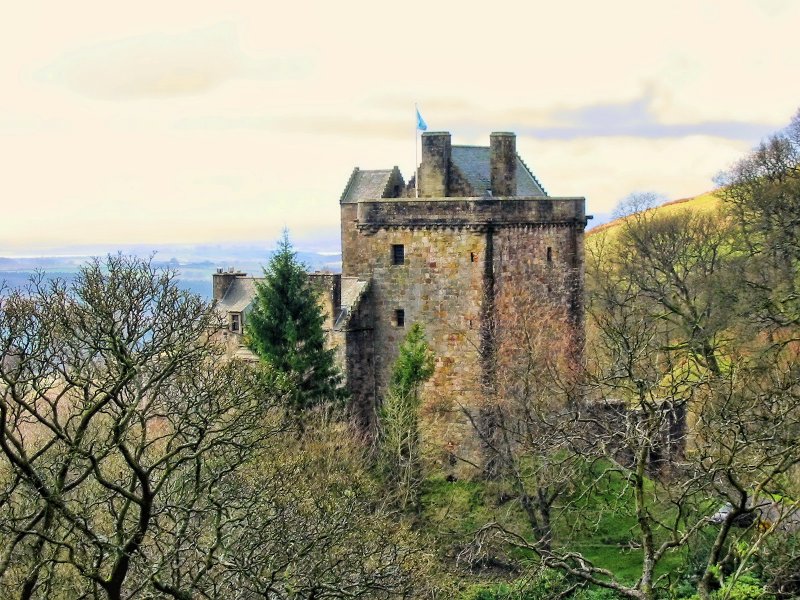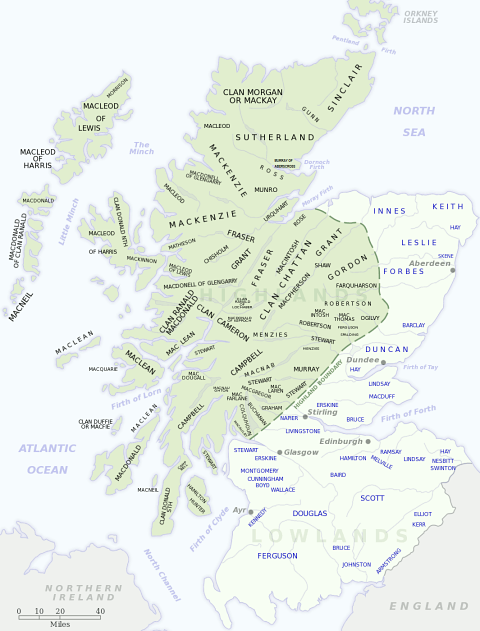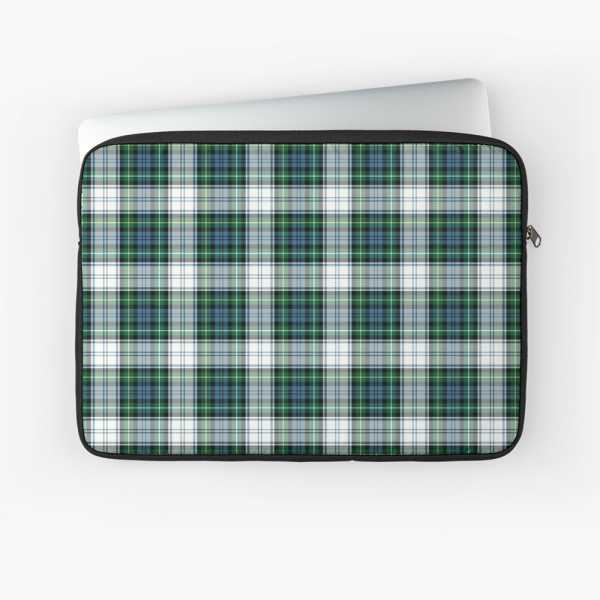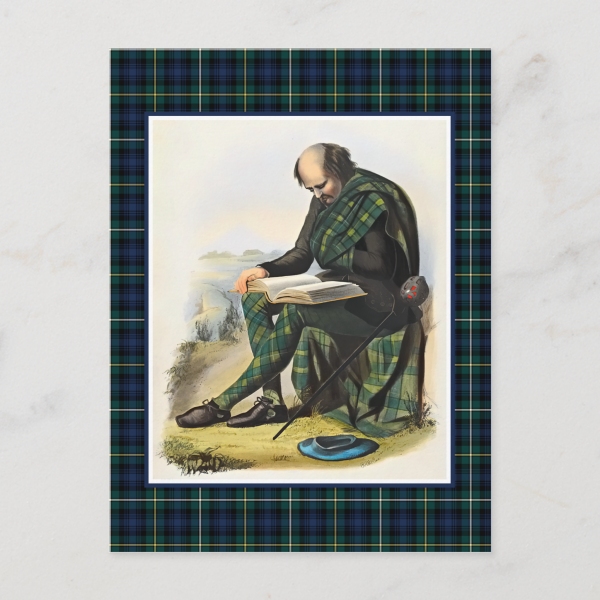
Motto: Ne Obliviscaris (Forget Not)
Historic Seat: Castle Campbell
District: Argyll
Associated Surnames: Burns, Caddell, Conochie, Denune, Fisher, Hastings, Hawes, Hawson, Lorne, Loudon, MacCarter, MacConnechy, MacConochie, MacDermid, MacDiarmid, MacGlasrich, MacIssac, MacIver, MacKellar, MacKelvie, MacKessock, MacLaws, MacLehose, Macoran, MacOwen, MacPhedran, MacPhun, MacTause, MacTavish, Macure, Pinkerton, Tawesson, Torry, Ure
Associated Tartans:
Early Campbell Genealogy and History:
(Excerpt from "The Scottish Clans and Their Tartans", James Grant, 1906)
The Campbell Clan, the most powerful in Scotland, rose upon the ruins of the MacDonalds, and their whole policy for ages, says a writer, was to supplant and ruin that race. The county of Argyll was for ages, and is still to a very considerable extent, inhabited by this great clan, whose duty it was to rally round the MacCailean Mhor, as their chief was designated; and many branches of the tribe were war-like and titled barons, who were bound to assist him in his feuds, without inquiring into his motives.
Sir Col Mòr Campbell, dominus del Lochauce was knighted in 1280 by Alexander III, "and from him," says Douglas, "the head of the family of Argyll is called MacCailean Mhor, in the Highlands to this day. By the time of Robert I," he adds, "the clan had become so numerous, that, unless locally designated, it was not easy to distinguish them, and many of the name basely swore fealty to Edward of England."
In Robertson's Index of Missing Charters, by Robert I, there are two to Duncan and Dougal Campbell, of "sundry lands in Argyll;" one to the latter of the Isle of Rosa, in Nether Lorn. "The first crown charter of the Argyll, or MacCailean Mhor branch of the name," says James Robertson, "for lands in Argyleshire, was one by King Robert Bruce to his nephew, Sir Colin, whose name is therein written Cambel - it is for the lands of Ardsonnachan, and dated at Arbroath 10th February 1316;" and the clan gradually increased in power, till, by conquest and marriage, it became the most influential in the kingdom.
During the minority of David II, Sir Colin Campbell of Lochawe stormed the Castle of Dunoon from the English, and was made governor thereof. His grandson, also Sir Colin, reduced the Western Highlands to the Royal Authority, and according to Martin's Genealogical Collections, was the immediate progenitor of the families of Ardkinglass, Ardentinie, Dunoon, Carrick, Skipness, Blytheswood, etc.
The first of the family ennobled was Sir Duncan who assumed the designation of Argyll, and was raised to the Peerage in 1445, by James II, as Lord Campbell. His grandson, Colin, second Lord Campbell, was ambassador to England, 1471-1474, and was created Earl of Argyll in 1480.
Archibald, second Earl of Argyll, led the vanguard at Flodden1, and lost his life with his royal master; Archibald, fourth Earl, opposed strenuously the proposed marriage of Queen Mary to Edward VI, "as derogatory to the honour of his country," and distinguished himself by his valour at Pinkie2 in 1547.
Archibald, seventh Earl, fought at Glenlevat3 in 1594: suppressed the MacGregors in 1603, and the MacDonalds, in the Western Isles in 1614.
His son, Sir Colin Mòr Campbell, commanded the Scots Foot Guards from 1641 till 1650, when the regiment was cut to pieces at the battle of Worcester4, and like his father, he lost his head in 1685, a victim of misrule rather than misjudgment. His son Archibald, tenth Earl, after the Revolution, was Colonel of the Horse Scots Guards, and in 1701 was created Duke of Argyll, Marquis of Kintyre and Lorne, Earl of Campbell and Cowal, Viscount Lochow and Glenyla, Lord Inverary, Mull, Morven and Tirie, by a patent, dated at Kensington, 23rd June.
His son, John, second Duke, became a field-marshal, and was one of the best soldiers of his time, and deserved the character given of him by Pope, as - "Argyll! the state's whole thunder born to wield, And shake alike the senate and the field."
He signalised himself at the battle of Ramilies and Ondenard, and the sieges of Lisle, Ghent, and Bruges. He commanded in Spain in 1710, and five years after, he fought, for the last time in the drawn battle of Sheriffmuir5. He had the Dukedom of Greenwich, which died with him in 1743, when the Scottish titles went to his brother Archibald, third Duke, who served under Marlborough, at the head of the 36th Foot, was Governor of Dumbarton, and High Treasurer of Scotland. He died in 1761, and was laid in Kilmun, the burial-place of his family. Being without issue, the title devolved on his cousin, General John Campbell of Mamore (second son of Archibald, ninth Earl), whose line is now represented by the present family. The fighting force of the Campbells was estimated at 5000 claymores in 1745.
John, fourth Duke, was the eldest son of the above-named John Campbell of Mamore. He died in 1770, and was succeeded by his son John, fifth Duke, who died in 1790. He left two sons, George, sixth Duke (d. 1839) and John, seventh Duke, who died in 1847, leaving George, eighth Duke (died 1900), whose eldest son John, married Princess Louise in 1871, and is the ninth and present Duke.
(End excerpt)
Next page: Clan Chisholm
Footnotes:
1 The Battle of Flodden (1513): The Battle of Flodden Field was fought on 9 September 1513, in Northumberland England between an army of Scots under King James IV and an English army commanded by the Earl of Surrey. Read more about the Battle of Flodden at Wikipedia.
2 The Battle of Pinkie Cleugh (1547): The Battle of Pinkie Cleugh was fought on 10 September 1547 on the banks of the River Esk near Musselburgh, Scotland. It was the last pitched battle between Scottish and English armies, and was a defeat for Scotland. Read more about the Battle of Pinkie Cleugh at Wikipedia.
3 The Battle of Glenlivet (1603): The battle of Glenlivet was fought on 3 October 1594, at Allanreid in the historic county of Banffshire near Moray, Scotland, and is often seen as a religious conflict. It was fought between the Catholic forces of George Gordon, 1st Marquess of Huntly and Francis Hay, 9th Earl of Erroll, who were victorious over the Protestant forces of Archibald Campbell, 7th Earl of Argyll. Read more about the Battle of Glenlivet at Wikipedia.
4 The Battle of Worcester (1651): The Battle of Worcester was fought on 3 September 1651 at Worcester, England and was the final battle of the English Civil War. Cromwell's army defeated King Charles II's army, of whom the vast majority were Scottish. Read more about the Battle of Worcester at Wikipedia.
5 The Battle of Sheriffmuir (1715): The Battle of Sheriffmuir was fought on 13 November 1715, led by John Erskine, 6th Earl of Mar, standard-bearer for the Jacobite cause in Scotland, and British Government forces, led by John Campbell, 2nd Duke of Argyll. It took place on the slopes of the Ochil Hills in Scotland, just inside the Perthshire border. Read more about the Battle of Sheriffmuir at Wikipedia.

Distribution of Scottish clans and families
View larger map at Wikimedia Commons

Browse the Clan Campbell Tartan Collection with home decor, personal accessories, crafting, paper products, and more.

Browse the Clan Campbell Dress Tartan Collection with clothing, home decor, accessories, electronics cases, and more.

Clan Campbell Postcard: Digitally cleaned and enhanced vintage illustration with tartan frame.